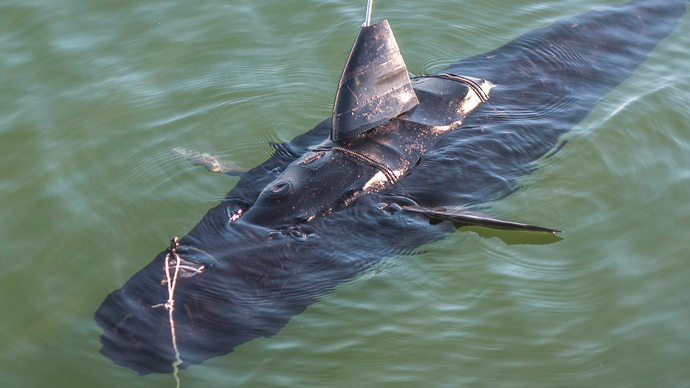Navy’s 100lb robotic 'spy fish' could take to sea next year

The Navy has been testing a robotic spy fish designed to resemble a five-foot, 100lb bluefin tuna. If it is operational next year, it will be used to patrol harbors, enter enemy territory, and report back on the movements of enemy ships.
While the Navy is currently testing its tuna-sized biometric device, the “Ghost Swimmer,” it has already provided data for future tasks it can undertake in environments featuring tides, varied currents, waves, and changing weather conditions. The device, created by the Office of Navy Research, has an oscillating tail, high maneuverability, and runs at many speeds. It also moves like a fish.
"This is an attempt to take thousands of years of evolution - what has been perfected since the dawn of time – and try to incorporate that into a mechanical device," Captain Jerry Lademan, a 27-year-old Marine leading the project, told The Virginian-Pilot. The idea is to "essentially reverse-engineer what nature has already done."
READ MORE:Pentagon’s DARPA funds unprecedented ‘Ferrari' of robotics (VIDEOS)
The biometric fish is controlled by a video game-style joystick, but it can also be programmed to travel on a set course and is sturdy enough to carry cameras and other naval equipment.
The Navy is hoping the motion of the fish will make it far less noticeable than most underwater vehicles. The Ghost Swimmer will potentially be able to evade sonar detection and enter enemy territory undetected to patrol and protect US ships and ports from harm.
READ MORE:5-foot-tall ‘Robocops’ start patrolling Silicon Valley
"The first time I saw it, I thought it was a living fish," Lademan said. "It looks alive. It's crazy."
Additionally, the biometric fish could be used to search for sea mines or inspect ship hulls for damage – two critical tasks that often put humans in harm's way.
READ MORE:‘Learning on the fly’: Brain-inspired neuromorphic chip tested in prototype drone
The Office of Naval Research, through its Rapid Innovation Cell – a group of junior Navy and Marine Corps officers tasked with putting emerging technologies to use for the military – has been playing around with 3D printers, augmented-reality glasses, and about 10 other breakthrough gadgets.













